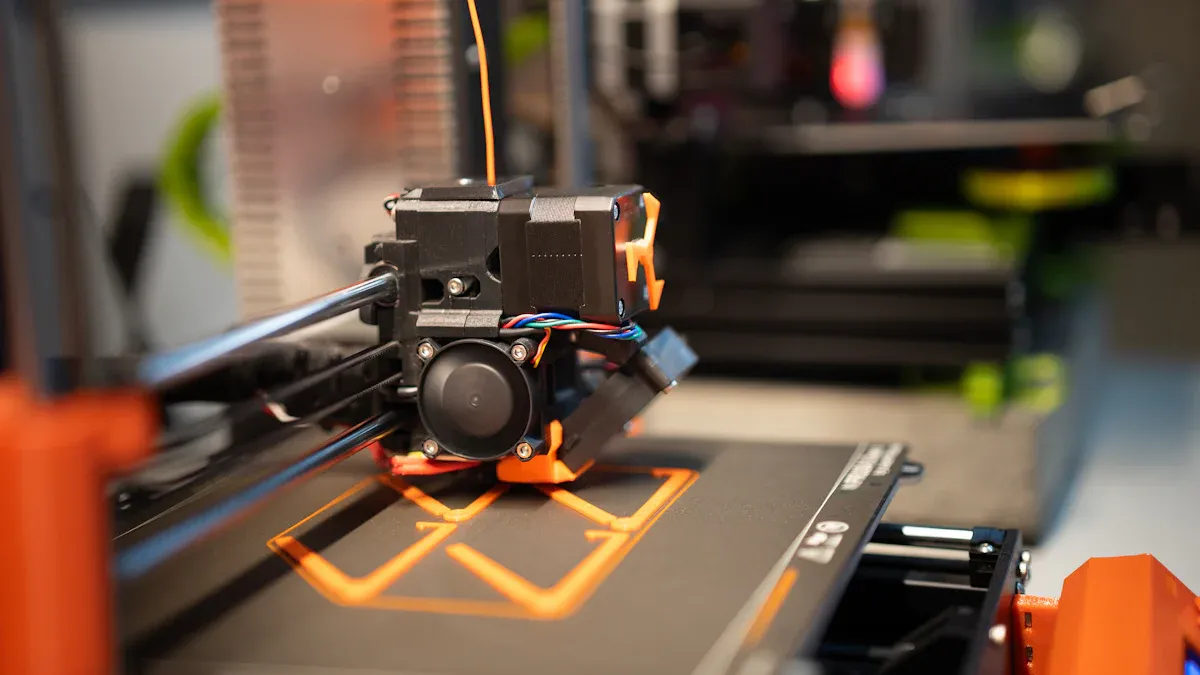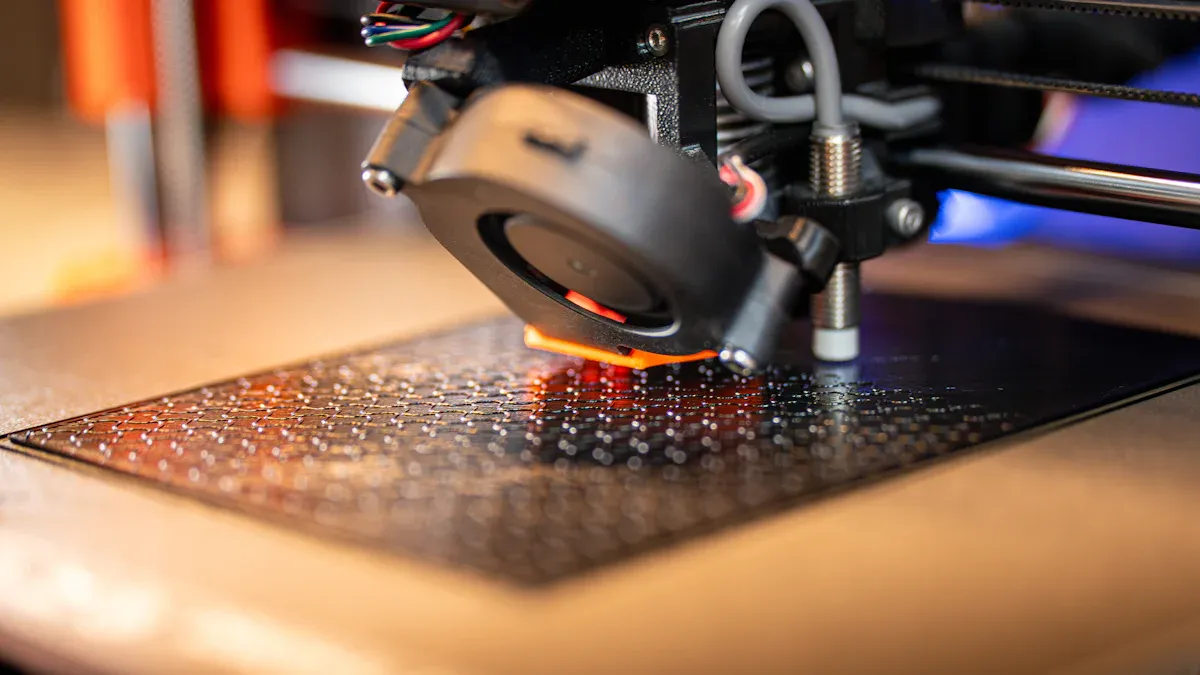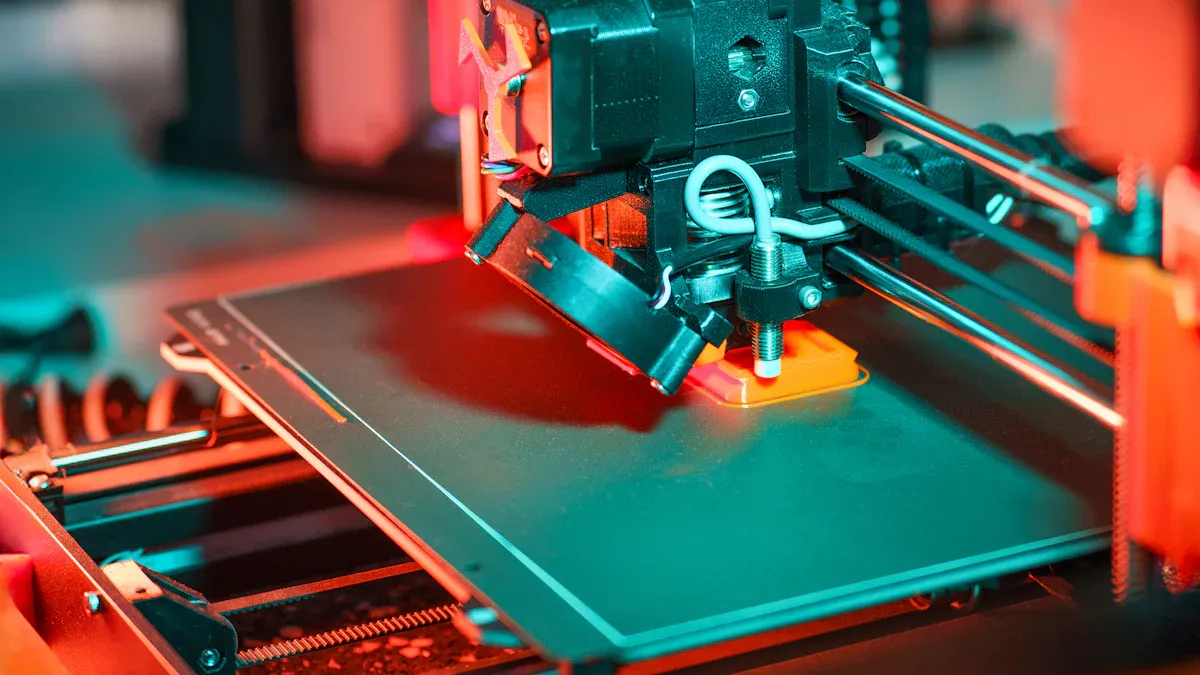
When creating prototypes, you need a manufacturing process that balances cost, speed, and precision. Injection molding and 3D printing are two popular methods. Injection molding excels in producing large volumes at low per-unit costs, especially when quantities exceed 8,000. For smaller runs, 3D printing offers flexibility and affordability, with costs dropping significantly as you scale up to 250 units. For example, a drone leg costs $32 per unit with 3D printing but drops to $24 at 250 units, while injection molding reduces this to $3 per part for higher volumes. Choosing the right method depends on your project's needs.
Injection molding is a manufacturing process that creates parts by injecting molten material into a mold. You can use this method to produce identical parts in large quantities. It works well for prototypes when you need durability and precision. The process begins with heating plastic or other materials until they melt. The molten material is then injected into a mold cavity, where it cools and solidifies into the desired shape.
Advanced statistical software facilitates efficient data analysis for injection molding processes. This includes tools like line graphs, histograms, and control charts, which help in understanding process conditions and addressing production issues.
To ensure quality, manufacturers often evaluate Cp and Cpk values. These metrics measure how well the process meets specifications.
When analyzing these metrics:
1. Always evaluate both Cp and Cpk together for a comprehensive understanding.
2. Focus on achieving a high Cp value first to improve Cpk performance.
3. Avoid selecting processes solely based on the highest Cpk value.
Injection molding is ideal for high-volume production, offering low per-unit costs and consistent quality.
Additive manufacturing, commonly known as 3D printing, builds objects layer by layer using digital models. Unlike injection molding, which requires molds, 3D printing directly creates parts from raw materials like plastics, metals, or resins. This process gives you the flexibility to design complex shapes without worrying about mold limitations.
You can use 3D printing for prototyping when speed and customization matter. It allows you to test multiple designs quickly and make adjustments without significant costs. For example, if you need a prototype with intricate details or unique geometries, additive manufacturing excels in delivering precision.
Additive manufacturing also supports a wide range of materials, making it suitable for diverse applications. However, it may not match the durability or cost-effectiveness of injection molding for large-scale production.

The production process for injection molding involves creating a mold, which serves as the template for manufacturing parts. Once the mold is ready, molten material is injected into it, cooled, and solidified to form identical parts. This method is ideal for high-volume production runs, as it ensures consistency and efficiency. However, the upfront tooling costs can be significant, often reaching around $10,000. This makes injection molding less suitable for small-batch prototyping or frequent design changes.
In contrast, 3D printing uses additive manufacturing techniques to build parts layer by layer directly from digital models. This eliminates the need for molds, reducing setup time and costs. 3D printing excels in rapid prototyping, allowing you to test multiple designs quickly without incurring additional tooling expenses. For example, while injection molding requires a workforce of 15 workers, 3D printing often involves fewer manual interventions, making it more adaptable for low-volume production.
| Method | Best For | Cost-Effectiveness | Production Volume |
|---|---|---|---|
| Injection Molding | Large volume production runs | More cost-effective for complex parts | High |
| 3D Printing | Small-batch, complex prototypes | No upfront tooling costs, but less efficient for high volumes | Low to medium |
Injection molding supports a wide range of materials, including plastics, metals, and composites. This versatility makes it suitable for applications requiring durable and heat-resistant parts. For example, the cost of raw materials for injection molding is approximately $8.9 per kilogram, which is significantly lower than the $38.4 per kilogram for 3D printing materials. However, the process may require specific material grades compatible with the mold design, limiting flexibility in some cases.
3D printing offers broader material compatibility, including thermoplastics, resins, and even advanced materials like carbon fiber composites. This flexibility enables mass customization and experimentation with unique material properties. For instance, architects can use 3D printing to create highly detailed models with parametric designs, leveraging materials that are difficult to process through traditional methods. While the material costs are higher, the ability to switch between materials without retooling makes 3D printing a preferred choice for prototyping services requiring frequent iterations.
Injection molding is well-suited for designs with simple geometries and high precision. The mold dictates the shape of the final product, which means you must finalize your design before production begins. While this ensures consistency, it limits the ability to create intricate or organic shapes. Prototype injection molding works best when your design is stable and requires minimal changes.
On the other hand, 3D printing offers unparalleled design flexibility. You can create complex geometries, including hollow structures and intricate details, without worrying about mold limitations. The technology integrates seamlessly with CAD and BIM software, ensuring every detail is captured accurately. Automation in the prototyping process allows for rapid prototyping, enabling quicker iterations and better decision-making. For example, generative design tools in 3D printing facilitate the creation of organic shapes that were previously impossible to achieve with traditional methods.
Tip: If your project involves unique geometries or requires frequent design changes, 3D printing is the better choice for prototyping.
When deciding between injection molding and 3D printing, production volume plays a critical role. Injection molding becomes more cost-effective as production scales up. The initial investment in molds is high, but the per-unit cost decreases significantly with larger quantities. For example, producing 10,000 units with injection molding can reduce the cost to as low as $0.50 per unit. This makes it ideal for high-volume production where consistency and efficiency are priorities.
In contrast, 3D printing is better suited for low-volume production. It eliminates the need for molds, allowing you to produce as few as 10 units at a cost of $20–$50 per unit. This flexibility makes 3D printing an excellent choice for prototyping or small-batch manufacturing. Additionally, 3D printing supports mass customization, enabling you to create unique designs for each unit without significant cost increases.
| Production Volume | Injection Molding (per unit) | 3D Printing (per unit) | Best Choice |
|---|---|---|---|
| 10 units | $100 – $200 | $20 – $50 | 3D Printing |
| 100 units | $10 – $20 | $15 – $40 | 3D Printing |
| 1,000 units | $1 – $5 | $12 – $35 | Injection Molding |
| 10,000 units | $0.50 – $2 | $10 – $30 | Injection Molding |
If your project involves low-volume production or frequent design changes, 3D printing offers unmatched flexibility. However, for high-volume production, injection molding provides significant cost savings and consistent quality.
Speed is another critical factor when choosing between injection molding and 3D printing. Injection molding requires time to design and manufacture molds, which can delay the start of production. Once the mold is ready, the process becomes highly efficient, producing thousands of parts in a short time. Companies like Protolabs can deliver injection molded prototypes in as little as a week, but any design changes require creating a new mold, adding time and cost.
On the other hand, 3D printing excels in rapid prototyping. You can modify CAD files and produce new prototypes within days. This makes it ideal for projects requiring quick iterations and design adjustments. For example, if you need to test multiple designs before finalizing one, 3D printing allows you to do so without significant delays.
Note: If your project demands quick turnarounds and frequent design updates, 3D printing is the faster option. However, for large-scale production with stable designs, injection molding offers better efficiency.
Understanding the cost dynamics of injection molding and 3D printing helps you make an informed decision. Injection molding involves high upfront costs for molds and machinery, but the per-unit cost decreases significantly with higher production volumes. For example, producing 1,000 units can reduce the cost to $1–$5 per part. However, the initial investment and setup costs make it less suitable for small runs.
3D printing, on the other hand, has no tooling costs, making it more affordable for low-volume production. Material costs for 3D printing are higher, ranging from $38.4 per kilogram compared to $8.9 per kilogram for injection molding. However, the ability to produce parts directly from digital models without additional setup costs offsets this expense.
Other costs include overhead and software licensing.
Cost Factors in Injection Molding:
For short production runs, 3D printing is often more cost-effective due to lower tooling costs and faster time-to-market. However, injection molding becomes more economical as production scales up, making it the preferred choice for high-volume production.

Prototype injection molding offers several advantages, especially for high-volume production. It is a cost-effective method for creating durable and precise prototype parts. Once the mold is ready, the process ensures consistent quality and tight tolerances, making it ideal for production-ready prototypes. You can also test various materials to find the best option for your prototyping applications. This flexibility helps you balance performance and cost.
Another key benefit is time efficiency. Rapid tooling allows you to produce cost-effective parts quickly, reducing the overall product development cycle. For example, using prototype injection molds can help you detect design flaws early and make necessary adjustments before full-scale production. This iterative process improves the final product while saving time and resources.
| Benefit | Description |
|---|---|
| Cost-Effectiveness | Lower tooling costs and reduced material waste lead to significant savings, especially for small runs. |
| Time Efficiency | Rapid tooling and shorter lead times enable faster product development cycles. |
| Design Validation | Prototyping allows for early detection of design flaws and iterative improvements based on testing. |
| Material Testing | Testing various materials helps in selecting the best option for performance and cost. |
Despite its benefits, prototype injection molding has some limitations. The high upfront costs for tooling can be a barrier, especially for small-scale prototyping services. Creating a mold requires significant time and resources, which may delay the start of production. If your design changes frequently, you will need new molds, adding to the cost and lead time.
Quality issues can also arise during the process. For instance, defects like short-shots may occur due to improper parameter settings. Addressing these defects requires careful analysis and adjustments, which can increase production time. Additionally, the large equipment needed for injection molding takes up space and requires skilled labor for operation. These factors make it less suitable for low-volume or highly customized prototypes.
Additive manufacturing, or 3D printing, excels in flexibility and speed. You can create complex geometries and customized designs without the need for molds. This makes it perfect for prototyping applications where frequent design changes are necessary. The ability to produce parts directly from digital models also reduces setup time, allowing you to test multiple designs quickly.
Another advantage is the low upfront cost. Unlike injection molding, 3D printing does not require expensive tooling, making it a cost-effective option for low-volume production. You can also use a wide range of materials, including advanced composites, to create unique prototypes. On-demand production further enhances its appeal, as you can produce parts as needed without maintaining large inventories.
Tip: Use 3D printing for prototyping when you need rapid iterations or highly detailed designs. It is especially useful for creating cost-effective prototype parts with intricate features.
While 3d printing offers many advantages, it also comes with limitations that you should consider. One of the most significant drawbacks is its slower production speed for large quantities. Unlike injection molding, which can produce thousands of identical parts in a short time, 3d printing builds each part layer by layer. This process makes it less efficient for high-volume production.
Another challenge lies in the cost of materials. The raw materials used in 3d printing, such as specialized resins or metal powders, are often more expensive than those used in traditional manufacturing. For instance, the cost per kilogram of 3d printing materials can be several times higher than that of injection molding materials. This can make 3d printing less economical for projects requiring multiple prototypes or large parts.
You may also encounter limitations in part strength and durability. While 3d printing excels in creating intricate designs, the parts it produces may not match the mechanical properties of those made through injection molding. Layer-by-layer construction can result in weaker bonds between layers, making the parts more prone to breaking under stress.
Lastly, the surface finish of 3d-printed parts often requires additional post-processing. You might need to sand, polish, or coat the parts to achieve a smooth finish, which adds time and cost to the process. These drawbacks highlight why 3d printing is better suited for low-volume, highly customized projects rather than mass production.
Note: Understanding these limitations will help you decide when 3d printing is the right choice for your prototyping needs.
Injection molding works best when you need to produce a large number of identical prototypes or parts. The process becomes more cost-effective as production volume increases because the high initial tooling costs are spread across many units. For example, producing 10,000 parts can reduce the cost per unit to as low as $0.50. This makes injection molding ideal for projects where consistency and efficiency are priorities.
If your prototype requires durability and tight tolerances, injection molding is the right choice. The process supports a wide range of materials, including heat-resistant and impact-resistant plastics. You can also test different materials to find the best option for your application. For instance, micromolding technology allows you to create small, precise parts while reducing tooling costs and lead times.
Tip: Use injection molding when your design is finalized, and you need high-quality prototypes for testing or production.
3D printing is the go-to option for rapid prototyping and small-batch production. It allows you to create parts directly from digital models without the need for molds. This eliminates setup costs and reduces lead times, making it perfect for projects requiring quick iterations. For example, you can modify your design in CAD software and produce a new prototype within days.
This method excels in creating complex geometries and intricate details. If your prototype involves unique shapes or hollow structures, 3D printing offers the flexibility to bring your ideas to life. The process also supports a wide range of materials, including advanced composites, enabling you to experiment with different properties.
| Metric | Description | Best Use Case |
|---|---|---|
| Resolution | Indicates the level of detail achievable in the printed prototype. | High-detail prototypes requiring fine features. |
| Speed | Refers to the time taken to produce a prototype. | Rapid prototyping scenarios needing quick results. |
| Material Versatility | The range of materials that can be used in the printing process. | Projects needing diverse material properties. |
| Cost-Effectiveness | The overall cost associated with the printing process. | Budget-sensitive projects prioritizing cost. |
Note: Choose 3D printing when you need flexibility, speed, and the ability to test multiple designs without incurring additional costs.
When deciding between injection molding and 3D printing, you should evaluate several key factors:
| Factor | Evidence |
|---|---|
| Budget Constraints | Future-proofing reduces costs and time for product improvements, indicating budget impacts. |
| Part Complexity | Design complexity can lead to increased production times, highlighting the effect of complexity. |
| Production Volume | Dedicated tooling costs are amortized over large quantities, showing the relationship with volume. |
You can also consider hybrid approaches that combine the strengths of both methods. For example, direct tooling offers the fastest turnaround for low volumes, while indirect tooling balances cost and scalability. By analyzing your project's requirements, you can find the optimal balance between cost, speed, and quality.
Tip: Always align your choice with your project's specific needs, such as the number of iterations, production run size, and complexity of the pieces.
Injection molding and 3D printing serve different purposes in prototyping. Injection molding excels in high-volume production with consistent quality, while 3D printing offers flexibility for small batches and complex designs. Your choice should depend on factors like budget, speed, and design complexity.
These technologies will continue to evolve, offering sustainable and integrated solutions for diverse manufacturing needs.
Injection molding uses molds to produce identical parts in large quantities. 3D printing builds parts layer by layer directly from digital models. Injection molding suits high-volume production, while 3D printing excels in low-volume, complex designs.
3D printing is faster for prototyping. It eliminates the need for molds, allowing you to create parts directly from digital files. Injection molding requires time to design and manufacture molds, which can delay the process.
Yes, you can combine both methods. Use 3D printing for initial prototypes to test designs quickly. Once finalized, switch to injection molding for high-volume production to reduce costs and ensure consistency.
3D printing is more cost-effective for small runs. It has no tooling costs and allows you to produce parts on demand. Injection molding becomes economical only when producing large quantities due to its high upfront tooling costs.
Injection molding supports plastics, metals, and composites, offering durability and heat resistance. 3D printing works with thermoplastics, resins, and advanced composites, providing flexibility for unique designs. Material choice depends on your project's requirements.